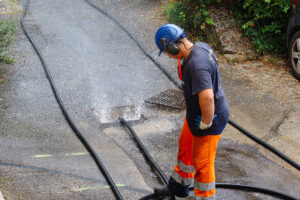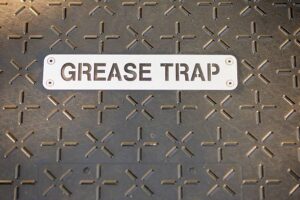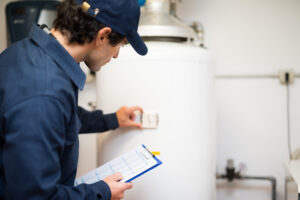Why is a leaning water heater a safety problem? Think about it for a second: you have a large standing tank with water heating up to 100 degrees Fahrenheit. Imagine that your leaning water heater becomes tilted, slowly moving toward the floor, so most of the water is at the bottom. Would your heating system still function as intended? Let’s find out more! Why Is A Leaning Water Heater A Safety Problem? Lately, there have been a lot of reports of leaning water heaters being a safety hazard. According to the National Fire Protection Association (NFPA), “Leaning water heaters are the leading cause of residential fires and injuries in the United States.” In fact, NFPA estimates that these types of accidents cause over $100 million in property damage each year. When a water heater begins to lean out of the plumbing, it will tug on the pipes attached to it at the top, along with the flue connector for gas or electric water heaters. A whole 40-gallon water heater is 500 pounds at its heaviest, making any lateral pressure placed on those connections hazardous. The pipes will eventually fracture from the pressure and cause a flood. If you’re planning to … Continue reading Leaning Water Heater: Is a Tilted Tank Dangerous?

High Velocity Water Jetting: Is It Right For You?
If you are facing a clogged drain in your home, then the time has come to think outside the box and look into high velocity water jetting services like those offered by Custom Plumbing of Arizona. Water jetting is a powerful method for quickly clearing a clog that can save you from having to call in a professional plumber all the time. With enough pressure, water can even cut through diamonds with ease! This article details how you will find out how water jetting is used, the cost, as well as how it benefits your home or business. What is High Velocity Water Jetting? If your drains are blocked, high velocity water jetting is a technique that can clear your drains in next to no time at all. This process pushes water at a tremendous velocity through your pipes and helps break down and remove any debris accumulated in your drains. Blocked drains can often cause toilets, sinks, and basins to malfunction as the water doesn’t drain away as quickly as it should. Many people try to use chemical drain cleaners, and although they can be helpful, they can also cause the condition of your pipes to deteriorate. As a … Continue reading High Velocity Water Jetting: Is It Right For You?

Clogged Drain Baking Soda Fix: How to Clear Your Drain Safely
Whether it’s clogged drains, backed-up sinks, or a flooded basement, we all have had to deal with some kind of drain blockage that won’t go away. In this article, learn how to fix these issues safely and effectively by using a few simple ingredients and items in your kitchen cabinet. How Does Baking Soda Unclog a Drain? Baking soda is a kitchen staple that can work wonders to clean drains that are smelly and clogged. In kitchen drains, common clogs come from fat, oil, and grease. For bathroom drains, baking soda is a great way to clean drains that are smelly and clogged. In kitchen drains, common clogs come from fat, oil, and grease. For bathroom drains, clogs often form from hair and scum from personal products. So before using chemical drain cleaners or disassembling the drain trap, try baking soda to see if it does the trick. How to Clean a Clogged Drain With Baking Soda and Vinegar If you’re having trouble getting your drains cleared, you may want to try using baking soda and vinegar. Here are some clogged drain baking soda techniques: Heat Boiling Water Boiling water can be heated in a large microwave-safe measuring cup or … Continue reading Clogged Drain Baking Soda Fix: How to Clear Your Drain Safely

How To Clean A Grease Trap: The 8 Best Ways
Did you know there are ways to keep a grease trap in good working order? In this article, we will give you some tips on how to clean a grease trap effectively! Grease traps are a common plumbing fixture found at home and across commercial establishments. These filters trap grease and other debris before it can reach your drains and sinks. As a result, they need to be cleaned regularly. What is the Importance of Installing a Grease Trap? Regular drain cleaning services can keep your plumbing in good shape. Grease traps are extremely important in preventing grease, and other food from ending up in your sewer system. This can cause blockages and flooding, which can lead to costly repairs. Plus, it’s illegal to discharge wastewater untreated into waterways. So, if you have a grease trap installed, clean it regularly and replace the filter if necessary. How to Clean a Grease Trap? Grease traps can be a pain to clean, but it’s important to do so on a regular basis. Here are 8 steps on how to clean a grease trap: Detach the lid from the grease trap gently with a pry bar There are grease trap gaskets right under … Continue reading How To Clean A Grease Trap: The 8 Best Ways

What Does it Cost to Replace Plumbing in an Old House?
What does it cost to replace plumbing in an old house? The cost to replace the plumbing in an old house depends on several factors. In this article, we try to lay out a general idea of the financial impact it could have on your bank account. Buying an old house and fixing it up—it’s a dream for many people, whether they are first-time homeowners or real estate investors. Unfortunately, when you buy an old house, there is a chance that the inner workings have severely deteriorated, and that includes one of the most important systems: the plumbing. Over time, regardless of the material used, plumbing corrodes and decays, leaving you, the homeowner, with an expensive mess. But just how much is it going to cost to replace plumbing in an old house that you own? Here’s what you need to know. Know the Signs That Your Plumbing Is Failing First things first, if you have not read our piece on the signs that your plumbing needs to be replaced, read that post before moving on. Done? Okay, let’s talk about costs. What Is the Range of Cost to Replace Plumbing in an Old House? If you are looking for … Continue reading What Does it Cost to Replace Plumbing in an Old House?

